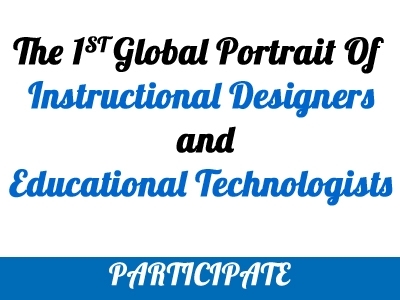Creating The First Global Portrait Of Instructional Designers And Educational Technologists
- Who are these Instructional Designers and Educational Technologists?
- Comparing Instructional Designers and Educational Technologists from across the word.
- Are Instructional Designers and Educational Technologists ready to meet the challenge of this new global education?
After twenty years in corporate training and fifteen years of teaching Educational Technology in a local Montreal University, I was always surprised when asked the age-old question, “but what do you do exactly? Even my kids have trouble explaining what their dad is doing and end up saying something like “he is a teacher that does something with computers”. Many of my colleagues also mention having similar difficulty explaining their work. I realized that very little research (except from anecdotal accounts) had been done trying to describe the amazing diversity and complexity of the work done by instructional designers and educational technologists.
The Global Context Of Instructional Designers And Educational Technologists
One of the key factors in this situation is the rapid growth in the use of digital leaning tools. In the last five years the development and use of educational technology has noticeably grown everywhere on the planet. In a recent UNESCO report (UNESCO, 2012), 10 countries have increased their use of online/distance education by over 30% per year and another dozen countries had a growth rate of over 15%.During the same period, we also see the emergence of several new tools (like smart phones and tablets) and innovative types of digital learning models, from the MOOCs /Massive Open Online Courses (like Coursera, EdX or Udacity), Open Educational Resources (like the Khan academy) or Global Online Accreditation (like the AMPAP program). It seems that the resistance to online education has almost completely disappeared in both the corporate and educational sectors. Organizations and individuals seem to finally be ready to use online / mobile learning has a key source of instruction.One of the main supporting reasons for this phenomenon might be that the research in the domain has also evolved greatly in the last 10 years. One of the key elements for me was a 2004 research done by one of my colleagues, Dr. Robert Bernard. His landmark meta-analysis study compared the performance results obtained between hundreds of digital/online courses and their classroom equivalent and found them to be equivalent (Bernard and Al., 2004). In the following years, more research supported this position, thus increasing the interest and support for digital learning.
The Need for a more Comprehensive Portrait Of Instructional Designers And Educational Technologists
One of the things I found even more interesting was that the architects and foot soldiers of this revolution have mostly stayed in the shadows. It is quite amazing that in a profession actually thriving, we know so little about the daily realities of the profession. So, two years ago I decided to start investigating this question. My first endeavour was to survey the Educational technology graduates of Concordia department where I teach (the oldest Educational Technology department in Canada). The results from this 2012 survey were amazing. For the first time we saw the great diversity and many challenges of our profession. Over 103 participants shared their professional information on a variety of topics from the type of work they do, their working conditions (salary, office, software…) or their professional development situation and needs. This information provided us on the realties and challenges of the profession and was also helpful in the redesign of our educational programs.
From the success of this first investigation, I decided that the next logical step was to create the first worldwide portrait of the profession. This would allow us to compare the professional realities of Instructional Designer and Educational Technologists from different countries / regions, but also from different backgrounds.To have a better perspective, we decided that the survey would be open to all Instructional designers and educational technologists, whether you have a diploma in the field or not (if they came in the profession through professional experience or from another domain).
As of January 1st, over 240 Educational Technologists and Instructional Designers from 32 countries have already completed the survey. With a target of over 300 to 350 participants, this would be the largest survey ever done for the profession. To thank everyone for their participation they will receive the executive summary of the survey results. The results of the survey will be published on eLearningindustry.com which is valuable supporter of this survey. All the individual information gathered will be held in total confidentially and only the aggregated data will appear in publications and presentations.
If you have not done so yet, I encourage you to take 15 min. to complete The First Global Portrait Of Instructional Designers' And Educational Technologists' Survey*
Thank you in advance for helping us shed some light on this exciting and expanding profession. We hope that this survey will help develop a better understanding of the development needs professionals will require to keep up with the evolving educational and instructional landscape.
References:Bernard, R. M., Abrami, P. C., et al. (2004). How does distance education compare with classroom instruction? A meta-analysis of the empirical literature. Review of Educational Research, 74(3), 379-439. doi: 10.3102/00346543074003379UNESCO Institute for Statistics, (2012). Global education digest 2012. Montreal: UNESCO.
*to access the survey just click the "The First Global Portrait Of Instructional Designers' And Educational Technologists' Survey" or https://www.surveymonkey.com/s/edtech2013globalsurvey








